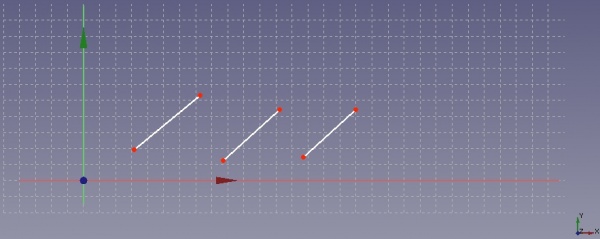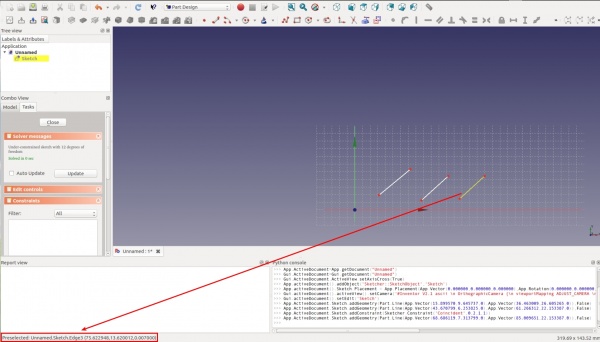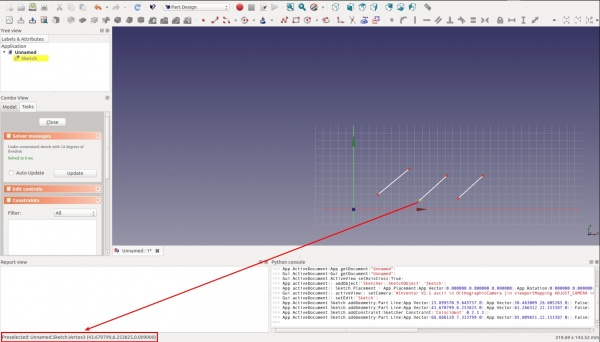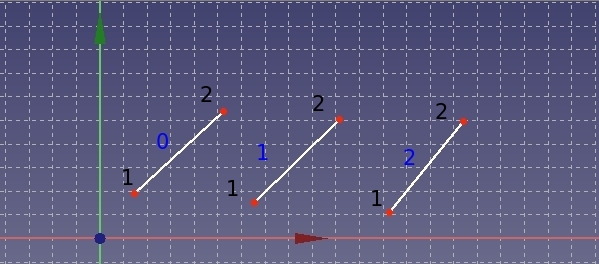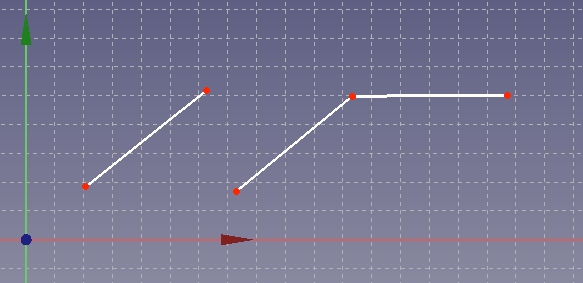Sketcher scripting/pl: Difference between revisions
(Created page with "Wiązanie 24px prawo Snell'a w kontekście skryptów zachowuje się jak wiązanie wymiarowe. Ponownie, zobacz odpowiednią stronę funkcji dla możliwych kombinacji argumentów dozwolonych dla każdego wiązania.") |
(Created page with "{| class="wikitable" |- ! Code !! Icon !! Feature |- | {{incode|"SnellsLaw"}} || 24px || prawo Snell'a |}") |
||
| Line 105: | Line 105: | ||
! Code !! Icon !! Feature |
! Code !! Icon !! Feature |
||
|- |
|- |
||
| {{incode|"SnellsLaw"}} || [[File:Sketcher_ConstrainSnellsLaw.svg|24px]] || [[Sketcher_ConstrainSnellsLaw|Snell' |
| {{incode|"SnellsLaw"}} || [[File:Sketcher_ConstrainSnellsLaw.svg|24px]] || [[Sketcher_ConstrainSnellsLaw/pl|prawo Snell'a]] |
||
|} |
|} |
||
Revision as of 16:25, 16 May 2023
Tworzenie obiektu Szkicu przy użyciu środowiska Python
Tworzymy obiekt Szkic w następujący sposób:
import FreeCAD as App
import Part
import Sketcher
doc = App.newDocument()
sketch = doc.addObject("Sketcher::SketchObject", "Sketch")
sketch.addGeometry(Part.LineSegment(App.Vector(1.2, 1.8, 0),
App.Vector(5.2, 5.3, 0)), False)
sketch.addGeometry(Part.LineSegment(App.Vector(6.5, 1.5, 0),
App.Vector(10.2, 5.0, 0)), False)
sketch.addGeometry(Part.LineSegment(App.Vector(12.2, 1.0, 0),
App.Vector(15.4, 5.0, 0)), False)
doc.recompute()
Dodaje również trzy linie w nowo utworzonym Szkicu.
Tworzenie wiązań przy użyciu środowiska Python
Wiązania geometryczne
oraz
można tworzyć z poziomu makropoleceń oraz z poziomu konsoli Python za pomocą następującego polecenia:
sketch.addConstraint(Sketcher.Constraint(ConstraintType, EdgeOrPartOfEdge…))
Wiązania wymiarowe
oraz specjalne
wiązanie prawo Snell'a można tworzyć z poziomu makropoleceń oraz konsoli Python za pomocą poniższego polecenia:
sketch.addConstraint(Sketcher.Constraint(DimensionalConstraintType, EdgeOrPartOfEdge…, App.Units.Quantity("float_value unit")))
na przykład
sketch.addConstraint(Sketcher.Constraint(DimensionalConstraintType, EdgeOrPartOfEdge…, App.Units.Quantity("123.0 mm")))
Pierwszy argument ConstraintType jest opisany poniżej w akapicie Rodzaje wiązań.
Wiązanie może przyjąć do sześciu argumentów, które są krawędziami lub wskazują, która część krawędzi jest używana przez wiązanie. Szczegóły dotyczące tego, jakie kombinacje krawędzi i ich części mogą być przekazane jako argumenty, znajdują się w dokumentacji poszczególnych wiązań. Głównym problemem w przypadku tej funkcji jest poprawne określenie numeru linii i numeru wierzchołka linii, które chcemy przetworzyć. Poniższe akapity opisują jak identyfikować numerację linii oraz jak identyfikować numerację części podrzędnych linii.
Rodzaje wiązań
W przypadku wiązań geometrycznych pierwszym argumentem jest jeden z poniższych. Aby uzyskać informacje na temat możliwych kombinacji argumentów dozwolonych dla każdego wiązania, zobacz odpowiednią stronę funkcji.
| Code | Icon | Feature |
|---|---|---|
"Coincident" |
Coincident | |
"PointOnObject" |
Point On Object | |
"Vertical" |
Vertical | |
"Horizontal" |
Horizontal | |
"Parallel" |
Parallel | |
"Perpendicular" |
Perpendicular | |
"Tangent" |
Tangent | |
"Equal" |
Equal | |
"Symmetric" |
Symmetric | |
"Block" |
Block |
W przypadku wiązań wymiarowych pierwszym argumentem jest jeden z poniższych. Zobacz odpowiednią stronę funkcji dla możliwych kombinacji argumentów dozwolonych dla każdego wiązania
| Code | Icon | Feature |
|---|---|---|
"DistanceX" |
Horizontal distance | |
"DistanceY" |
Vertical distance | |
"Distance" |
Distance | |
"Radius" |
Radius | |
"Diameter" |
Diameter | |
"Angle" |
Angle | |
"AngleViaPoint" |
Angle |
Wiązanie prawo Snell'a w kontekście skryptów zachowuje się jak wiązanie wymiarowe. Ponownie, zobacz odpowiednią stronę funkcji dla możliwych kombinacji argumentów dozwolonych dla każdego wiązania.
| Code | Icon | Feature |
|---|---|---|
"SnellsLaw" |
prawo Snell'a |
The Lock constraint is a GUI command which creates a
Horizontal distance and a
Vertical distance constraint, it is not a constraint of its own.
Rozpoznawanie numeracji linii
Narysowałem trzy linie, jak pokazano na poniższym rysunku.
Przesuwając kursor myszy nad linią jej numer można zobaczyć w lewym dolnym rogu okna programu FreeCAD, patrz następny rysunek.
Niestety numeracja wyświetlana w oknach programu FreeCAD zaczyna się od 1, podczas gdy numeracja linii użytej w skrypcie zaczyna się od 0: oznacza to, że musisz odjąć jeden za każdym razem, gdy chcesz odwołać się do linii.
Positive numbers indicate sketch edges (straight lines, circles, conics, B-splines, and so on). The following values can be used to denote elements that are not sketch edges:
-1denotes the horizontal x axis-2denotes the vertical y axis-ndenotes the external geometry element numbern-3(e.g. the external geometry element with index 0 in the flattened listsketch.ExternalGeometrywould be denoted by -3, the following element in the flattened list would be -4 and so on).
Rozpoznawanie numeracji części składowych linii
When qualifying which part of a line is affected by a constraint, the following values can be used:
0to indicate that the constraint affects the entire edge.1to indicate that the constraint affects the starting point of the edge (a full circle has no starting point).2to indicate that the constraint affects the end point of the edge.3to indicate that the constraint affects the center point of the edge. For Circles and
Circles and  Conics (ellipses), this is the center of the circle or center (intersection of major and minor axes) of the ellipse. For straight
Conics (ellipses), this is the center of the circle or center (intersection of major and minor axes) of the ellipse. For straight Lines,
3cannot be used to indicate the center point.nto indicate that the constraint affects the n-th pole of a B-Spline.
B-Spline.
The vertices indicated by 1 and 2 are numbered according to their order of creation. To find out the order of their creation (If you have a lot of lines, you cannot remember which vertex you have created first), you just have to move the cursor of your mouse above the two vertices of one line, see following figure.
If you read e.g. 4 and 5, it means that the vertex with the lower number (4 in this example) will be referenced by using the number 1 (first in the script command and the vertex with the higher number (5 in this example) will be referenced by using the number 2 in the script command.
Przykład
Let us take the previous example of the three lines. The subsequent figure indicates the numbering of each line and their vertices according to the convention for scripting.
blue text: numbering of line, black text: numbering of vertices
The command sketch.addConstraint(Sketcher.Constraint("Coincident", 1, 2, 2, 1)) yields following result:
The full code to draw the three lines and add a Coincident constraint on two points from two lines is like this:
import FreeCAD as App
import Part
import Sketcher
doc = App.newDocument()
sketch = doc.addObject("Sketcher::SketchObject", "Sketch")
sketch.addGeometry(Part.LineSegment(App.Vector(1.2, 1.8, 0),
App.Vector(5.2, 5.3, 0)), False)
sketch.addGeometry(Part.LineSegment(App.Vector(6.5, 1.5, 0),
App.Vector(10.2, 5.0, 0)), False)
sketch.addGeometry(Part.LineSegment(App.Vector(12.2, 1.0, 0),
App.Vector(15.4, 5.0, 0)), False)
sketch.addConstraint(Sketcher.Constraint("Coincident", 1, 2, 2, 1))
doc.recompute()
- Przybory: Nowy szkic, Edycja szkicu, Mapuj szkic na powierzchnię, Zmień orientację szkicu, Sprawdź poprawność szkicu, Połącz szkice, Odbicie lustrzane szkicu, Zamknij szkic, Widok szkicu, Widok przekroju, Włącz / wyłącz siatkę, Włącz / wyłącz przyciąganie, Kolejność renderowania, Przerwij operację
- Geometrie szkicownika: Punkt, Linia, Komponent utwórz łuk, Łuk, Utwórz łuk przez 3 punkty, Komponent utwórz okrąg, Okrąg, Utwórz okrąg przez 3 punkty, Komponent utwórz stożek, Utwórz elipsę względem środka, Utwórz elipsę przez 3 punkty, Utwórz łuk elipsy, Utwórz łuk hyperboli, Utwórz łuk paraboli, Komponent utwórz krzywą złożoną, Utwórz krzywą złożoną, Utwórz okresową utwórz krzywą złożoną, Polylinia (linia wielopunktowa), Prostokąt, Komponent utwórz wielokąt foremny, Trójkąt, Kwadrat, Pięciokąt, Sześciokąt, Siedmiokąt, Ośmiokąt, Utwórz wielokąt foremny, Rowek, Zaokrąglenie, Zaokrąglenie z zachowaniem wiązań, Przytnij, Rozszerz, Geometria zewnętrzna, Kalka techniczna, Tryb konstrukcyjny
- Wiązania szkicownika
- Wiązania geometryczne Wiązanie zbieżności punktów, Wiązanie punktu na obiekcie, Wiązanie pionowe, Wiązanie poziome, Wiązanie równoległości, Wiązanie prostopadłości, Wiązanie styczności, Wiązanie równości, Wiązanie symetrii, Wiązanie zablokowania
- Wiązania wymiarów Wiązanie blokady odległości, Zwiąż odległość poziomą, Zwiąż odległość pionową, Wiązanie odległości, Wiązanie promienia, Wiązanie średnicy, Zwiąż automatycznie promień / średnicę, Wiązanie kąta, Wiązanie prawo Snella
- Narzędzia wiązań: Przełącz kontrolę wiązania, Przełącz aktywność wiązania
- Narzędzia szkicownika Wybierz elementy bez wiązań, Wybierz powiązane więzy, Wybierz powiązaną geometrię, Wybierz zbędne wiązania, Wybierz wiązania konfliktowe, Pokaż / ukryj geometrię wewnętrzną, Wybierz odniesienie położenia, Wybierz oś poziomą, Wybierz oś pionową, Odbicie lustrzane, Klonuj, Kopiuj, Przesuń, Szyk prostokątny, Usuń wyrównanie osi, Usuń wszystkie geometrie, Usuń wszystkie wiązania
- Narzędzia B-spline dla szkicownika. Pokaż / ukryj stopień krzywej złożonej, Pokaż/ukryj ramkę kontrolną krzywej złożonej, Pokaż / ukryj grzebień krzywizny krzywej złożonej, Pokaż / ukryj wyświetlanie węzłów krzywej złożonej, Pokaż / ukryj wagę punktu kontrolnego krzywej złożonej, Konwertuj geometrię na krzywą złożoną, Zwiększ stopień krzywej złożonej, Zmniejsz stopień krzywej złożonej, Zwiększ krotność węzłów krzywej złożonej, Zmniejsz krotność węzła krzywej złożonej, Wstaw węzeł, Połącz krzywe
- Przestrzeń wirtualna szkicownika Przełącz przestrzeń wirtualną
- Dodatkowe: Okienko dialogowe Szkicownika, Preferencje, Skrypty Szkicownika
- Jak zacząć
- Instalacja: Pobieranie programu, Windows, Linux, Mac, Dodatkowych komponentów, Docker, AppImage, Ubuntu Snap
- Podstawy: Informacje na temat FreeCAD, Interfejs użytkownika, Profil nawigacji myszką, Metody wyboru, Nazwa obiektu, Edytor ustawień, Środowiska pracy, Struktura dokumentu, Właściwości, Pomóż w rozwoju FreeCAD, Dotacje
- Pomoc: Poradniki, Wideo poradniki
- Środowiska pracy: Strona Startowa, Architektura, Assembly, CAM, Rysunek Roboczy, MES, Inspekcja, Siatka, OpenSCAD, Część, Projekt Części, Punkty, Inżynieria Wsteczna, Robot, Szkicownik, Arkusz Kalkulacyjny, Powierzchnia 3D, Rysunek Techniczny, Test Framework
